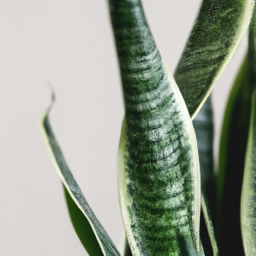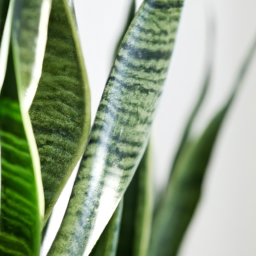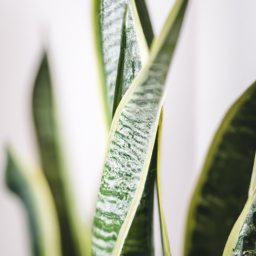
If you’re a fan of houseplants and are looking to add some greenery to your home, you may have come across the popular and easy-to-care-for snake plant. But did you know that there are actually many different snake plant varieties to choose from? From the classic Sansevieria trifasciata to the unique Sansevieria cylindrica, each type of snake plant brings its own charm and characteristics to your indoor space. In this blog post, we’ll explore the world of different snake plants and help you decide which one is right for you. So, let’s dive in and discover the beauty of these versatile and stunning plants!
Types of Snake Plants: A Guide to Different Varieties
Welcome to our comprehensive guide on the various types of snake plants! If you’re a plant enthusiast looking to expand your collection or a beginner looking to add some greenery to your space, snake plants are a great choice. These low-maintenance plants are not only beautiful but also have air-purifying properties, making them a popular choice for indoor spaces.
Sansevieria trifasciata
One of the most common varieties of snake plants is the Sansevieria trifasciata, also known as the mother-in-law’s tongue. This variety has long, upright leaves with green and yellow stripes, giving it a striking appearance. The Sansevieria trifasciata is a hardy plant that can thrive in a variety of conditions, making it perfect for beginners or those with a busy lifestyle.
When caring for a Sansevieria trifasciata, it’s important to place it in a well-draining pot and water it sparingly. These plants are drought-tolerant and can survive in low light conditions, making them a versatile choice for any indoor space. To keep your Sansevieria trifasciata looking its best, wipe the leaves with a damp cloth to remove dust and keep pests at bay.
In terms of propagation, Sansevieria trifasciata can be easily propagated through division or leaf cuttings. Simply separate the rhizomes or cut a leaf into sections and plant them in a well-draining soil mix. With proper care, your Sansevieria trifasciata will thrive and grow into a beautiful, healthy plant.
Sansevieria cylindrica
Another popular variety of snake plant is the Sansevieria cylindrica, also known as the cylindrical snake plant. This variety has cylindrical, upright leaves with pointed ends, giving it a unique and modern look. The Sansevieria cylindrica is a great choice for those looking to add a touch of elegance to their space.
When caring for a Sansevieria cylindrica, it’s important to place it in a well-draining pot and water it sparingly. These plants prefer bright, indirect light but can also tolerate low light conditions. To keep your Sansevieria cylindrica looking its best, wipe the leaves with a damp cloth to remove dust and keep pests at bay.
Propagation of Sansevieria cylindrica can be done through division or leaf cuttings. Simply separate the rhizomes or cut a leaf into sections and plant them in a well-draining soil mix. With proper care and attention, your Sansevieria cylindrica will grow into a stunning plant that will be the envy of all your friends.
Sansevieria moonshine
The Sansevieria moonshine is a unique variety of snake plant with silvery-green leaves that have a subtle shimmer, giving it a moonlit appearance. This variety is perfect for those looking to add a touch of elegance and sophistication to their space. The Sansevieria moonshine is a relatively new variety that has quickly gained popularity among plant enthusiasts.
When caring for a Sansevieria moonshine, it’s important to place it in a well-draining pot and water it sparingly. These plants prefer bright, indirect light but can also tolerate low light conditions. To keep your Sansevieria moonshine looking its best, wipe the leaves with a damp cloth to remove dust and keep pests at bay.
Propagation of Sansevieria moonshine can be done through division or leaf cuttings. Simply separate the rhizomes or cut a leaf into sections and plant them in a well-draining soil mix. With proper care and attention, your Sansevieria moonshine will grow into a stunning plant that will brighten up any room.
With so many different varieties of snake plants to choose from, there’s sure to be one that suits your style and space. Whether you’re looking for a classic Sansevieria trifasciata, a modern Sansevieria cylindrica, or a unique Sansevieria moonshine, these plants are a great choice for any plant lover. With their low-maintenance nature and air-purifying properties, snake plants are a must-have for any indoor space.

Comparing Different Snake Plant Varieties: Size, Shape, and Color
Snake plants, also known as Sansevieria, are popular houseplants known for their striking appearance and low maintenance requirements. There are several different varieties of snake plants, each with its own unique characteristics. In this guide, we will compare the size, shape, and color of some of the most popular snake plant varieties to help you choose the perfect one for your home.
Size
When it comes to size, snake plants can vary widely depending on the variety. Some varieties, such as the Sansevieria trifasciata, commonly known as the mother-in-law’s tongue, can grow up to three feet tall, making them a great choice for adding height to a room. On the other hand, smaller varieties like the Sansevieria cylindrica, also known as the cylindrical snake plant, typically reach a maximum height of around one to two feet, making them ideal for smaller spaces or tabletop displays.
In terms of width, most snake plants have a similar spread, with their leaves growing in a tight cluster from a central point. However, some varieties, such as the Sansevieria masoniana, or whale fin snake plant, have broader leaves that can reach up to six inches in width, creating a more substantial presence in a room.
When choosing a snake plant based on size, consider the dimensions of the space where you plan to place it. Taller varieties work well in corners or as a focal point in a room, while smaller varieties are perfect for shelves, desks, or windowsills.
Shape
Snake plants come in a variety of shapes, from the classic sword-like leaves of the Sansevieria trifasciata to the cylindrical, tube-shaped leaves of the Sansevieria cylindrica. Some varieties, such as the Sansevieria boncellensis, have twisted or contorted leaves that add a unique and sculptural element to the plant.
The shape of a snake plant’s leaves can also vary in texture, with some varieties having smooth, glossy leaves, while others, like the Sansevieria hahnii, or bird’s nest snake plant, have a more textured or rippled appearance. The shape of a snake plant’s leaves can impact its overall aesthetic, so consider the style of your home and the look you want to achieve when choosing a variety.
In addition to the shape of the leaves, some snake plant varieties, such as the Sansevieria kirkii, have variegated foliage with striking patterns of light and dark green, yellow, or white. These variegated varieties can add a pop of color and visual interest to your indoor garden.
Color
While snake plants are known for their striking green foliage, the color of their leaves can vary depending on the variety. Most snake plants have dark green leaves, but some varieties, such as the Sansevieria trifasciata ‘Moonshine,’ have lighter green or silvery-gray leaves that add a subtle touch of color to a room.
In addition to green, some snake plant varieties, like the Sansevieria cylindrica ‘Boncel,’ have leaves with horizontal striping in shades of green and gray, creating a visually interesting pattern. Other varieties, such as the Sansevieria trifasciata ‘Black Coral,’ have dark green leaves with hints of black, adding a dramatic flair to the plant.
When choosing a snake plant based on color, consider the overall color scheme of your home and the mood you want to create in the space. Lighter varieties can brighten up a room, while darker varieties can add a touch of sophistication and drama.
In conclusion, when comparing different snake plant varieties based on size, shape, and color, consider the dimensions of your space, the style of your home, and the overall aesthetic you want to achieve. Whether you prefer tall and dramatic or small and sculptural, there is a snake plant variety to suit every taste and space. Experiment with different varieties to create a lush and vibrant indoor garden that brings a touch of nature into your home.

Caring for Different Snake Plant Species: Tips and Tricks
The Sansevieria Trifasciata
When it comes to caring for different snake plant species, the Sansevieria Trifasciata is one of the most popular choices among plant enthusiasts. This plant, also known as the mother-in-law’s tongue, is known for its striking green leaves with yellow edges. To care for this plant, it is important to place it in a well-lit area, as it thrives in bright, indirect sunlight. However, it can also tolerate low light conditions, making it a versatile choice for any home.
In terms of watering, the Sansevieria Trifasciata prefers to dry out between waterings. It is important not to overwater this plant, as it is susceptible to root rot. Water the plant thoroughly, allowing excess water to drain out of the bottom of the pot. During the growing season, fertilize the plant once a month with a balanced fertilizer to promote healthy growth.
One of the key benefits of the Sansevieria Trifasciata is its air-purifying properties. This plant is known to remove toxins from the air, making it a great choice for indoor spaces. To keep your plant looking its best, wipe down the leaves with a damp cloth to remove dust and keep them looking shiny.
The Sansevieria Cylindrica
Another popular snake plant species is the Sansevieria Cylindrica, also known as the cylindrical snake plant. This plant is characterized by its long, cylindrical leaves that grow upright in a fan shape. To care for this plant, it is important to place it in a well-draining potting mix and water it sparingly. The Sansevieria Cylindrica is drought-tolerant and prefers to dry out between waterings.
In terms of lighting, this plant thrives in bright, indirect sunlight but can also tolerate low light conditions. Rotate the plant occasionally to ensure even growth on all sides. During the growing season, fertilize the plant every few months with a balanced fertilizer to promote healthy growth.
The Sansevieria Cylindrica is a low-maintenance plant that is perfect for beginners. It is known for its air-purifying properties and can help improve indoor air quality. To keep your plant looking its best, remove any dead or yellowing leaves and repot it every few years to refresh the soil.
The Sansevieria Moonshine
The Sansevieria Moonshine is a unique snake plant species that is prized for its silvery-green leaves. This plant is a hybrid variety that combines the best traits of the Sansevieria Trifasciata and the Sansevieria Cylindrica. To care for this plant, it is important to place it in a well-draining potting mix and water it sparingly. The Sansevieria Moonshine is drought-tolerant and prefers to dry out between waterings.
In terms of lighting, this plant thrives in bright, indirect sunlight but can also tolerate low light conditions. Rotate the plant occasionally to ensure even growth on all sides. During the growing season, fertilize the plant every few months with a balanced fertilizer to promote healthy growth.
The Sansevieria Moonshine is a stunning addition to any indoor space and is known for its air-purifying properties. To keep your plant looking its best, wipe down the leaves with a damp cloth to remove dust and keep them looking shiny. With proper care and attention, your Sansevieria Moonshine will thrive and bring beauty to your home.
I’ll leave you with these final thoughts
Snake plants, also known as Sansevieria, are popular houseplants due to their low maintenance and air-purifying properties. There are several different varieties of snake plants, each with its own unique characteristics that make them stand out. One popular variety is the Sansevieria trifasciata, also known as the mother-in-law’s tongue, which features long, pointed leaves with yellow edges. Another striking variety is the Sansevieria cylindrica, which has cylindrical leaves that grow upright like spikes.
If you’re looking for a more compact snake plant, the Sansevieria hahnii is a great choice with its short, rosette-like leaves that form a tight cluster. For those who prefer a more colorful option, the Sansevieria moonshine is a stunning variety with silvery-green leaves that add a touch of elegance to any space. No matter which variety you choose, snake plants are sure to add a touch of greenery and style to your home while requiring minimal care.
Let me leave you with some FAQs:
Q1. What are some different types of snake plants?
A1. There are several varieties of snake plants, including the Sansevieria trifasciata (commonly known as the mother-in-law’s tongue), Sansevieria cylindrica, and Sansevieria boncel.
Q2. How do I care for different types of snake plants?
A2. Different snake plants have similar care requirements, such as bright indirect light, well-draining soil, and infrequent watering. However, specific care instructions may vary slightly depending on the variety.
Q3. Can I mix different types of snake plants in the same pot?
A3. Yes, you can mix different types of snake plants in the same pot as long as they have similar care requirements. This can create a visually interesting display of different shapes and sizes.
Q4. Are there any rare or unique varieties of snake plants?
A4. Yes, there are rare and unique varieties of snake plants, such as the Sansevieria masoniana (Mason’s Congo) with its large, paddle-shaped leaves, or the Sansevieria kirkii (Star Sansevieria) with its striking silver-green foliage.
Q5. Where can I find different types of snake plants to purchase?
A5. Different types of snake plants can be found at local nurseries, plant shops, or online retailers specializing in houseplants. Make sure to research the specific variety you are interested in to find the best source for purchasing.
Dr. Olivia Green is a botanist with over two decades of experience in indoor plant cultivation. She holds a Ph.D. in Plant Biology and has dedicated her career to researching plant behavior in controlled environments. Dr. Green is passionate about helping plant enthusiasts master the art of indoor gardening through her extensive knowledge and practical insights.


